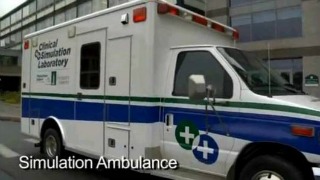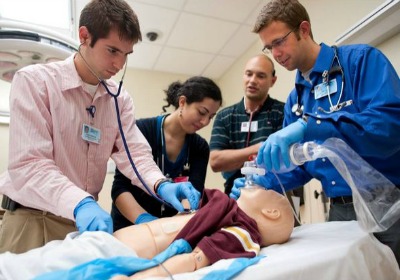Simulation 2.0: A Test Lab for Health Care Transformation
Ted James, MD, Director of the Clinical Simulation Laboratory, provides an update on what to expect from the "Sim Lab" in 2013.
 What does simulation have to do with health care reform? More than you may think.
What does simulation have to do with health care reform? More than you may think.
Health care is undergoing a period of unprecedented transformation, during which simulation has emerged as a powerful tool to ensure patient safety and quality. However, simulation also provides the ability to design and model innovations in health care process, and then study the impact of these innovations in a controlled learning environment prior to wide-scale implementation. It's an ideal opportunity to simulate processes to help achieve accountable care and high-reliability within a value-driven health delivery system.
One way we use simulation to achieve process improvement is through our mobile, 'in-situ' simulation program. We essentially bring the simulation laboratory into the health care facility where scenarios can be performed using actual hospital environments, equipment and staff in order to assess teamwork, efficiency and systems-based factors affecting quality.
For example, our converted ambulance, the "Simbulance," provides the setting for realistic patient transport scenarios as well as bringing our equipment to area hospitals and other off-site locations. The mobile simulation program is very effective in assessing team response as well as hospital process during emergency scenarios. The results tend to be quite enlightening, especially during the debriefing session when people analyze and reflect on their performance.
Participants typically recognize areas where they can improve efficiency and reduce waste. For example, following one scenario, members of a clinical team realized that some of the same activities being performed were needlessly redundant. They discovered better ways to organize the team and allocate tasks in a way that added value to patient care. In another case, a nurse identified that the procedure kits they were using during a resuscitation scenario could be standardized to streamline care and improve results.
What we also continually discover in simulation is just how critical team collaboration and communication are to patient care. It's a little surprising, but most negative outcomes are not the result of technical incompetence or lack of medical knowledge, they are from communication breakdowns or poor team coordination. Therefore, we use simulation to enhance the performance of our clinical teams by designing programs focused on effective clinical communication and inter-professional teamwork. It's not that we won't provide technical skills training, but we also go beyond procedural skills and use simulation to help create well-organized, high-functioning teams – which deliver better patient care.
Looking forward, the Clinical Simulation Lab is looking to redesign health care to enhance patient-centered care and value.
Here's some of what you can expect to see this year and beyond:
Simulation programs aimed at enhancing the patient experience, reducing patient wait times and eliminating unplanned readmissions to the hospital.
Programs incorporating human factors and usability testing to optimize the use of electronic health records and new medical technology. We can beta-test new medical devices in simulation to reveal potential hidden problems that may otherwise go unnoticed until used in actual patient care..
We are developing programs to help parents care for children with special medical needs at home.
I'm personally very excited about an upcoming community program where we are going to simulate an emergency room trauma resuscitation following a texting-related car accident. This is part of a community program delivering a message about the dangers of texting-while-driving to local high school students.
The future of simulation in health care is quite promising. We believe that simulation saves lives; and furthermore, that it can help bring about transformations in health care delivery leading to safer, more efficient, reliable systems of patient care.
Ted James, MD, is medical director of the Clinical Simulation Laboratory at the UVM Medical Center and the UVM Larner College of Medicine. He is also a surgical oncologist at the UVM Medical Center and associate professor at the UVM Larner College of Medicine.
The Clinical Simulation Laboratory provides health care professionals with a comprehensive, practical, and innovative solution to today's clinical training and health care improvement needs in a safe, convenient, and controlled learning environment.
Read the blog post on the University of Vermont Medical Center blog >>